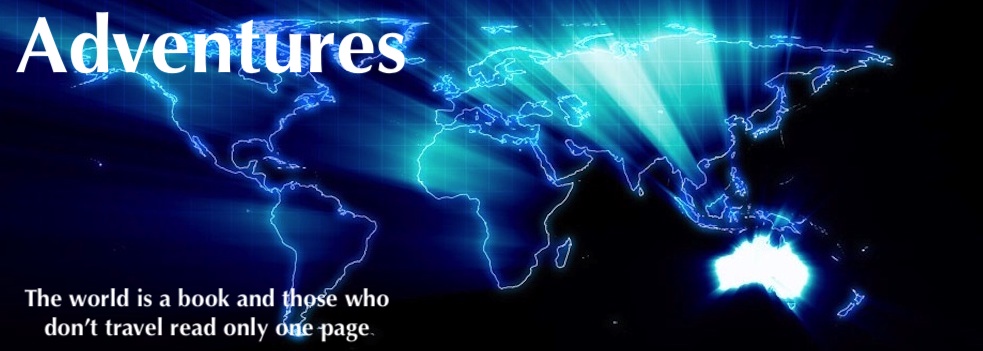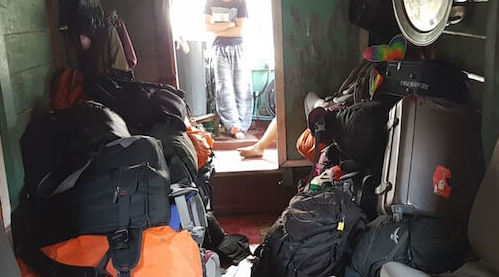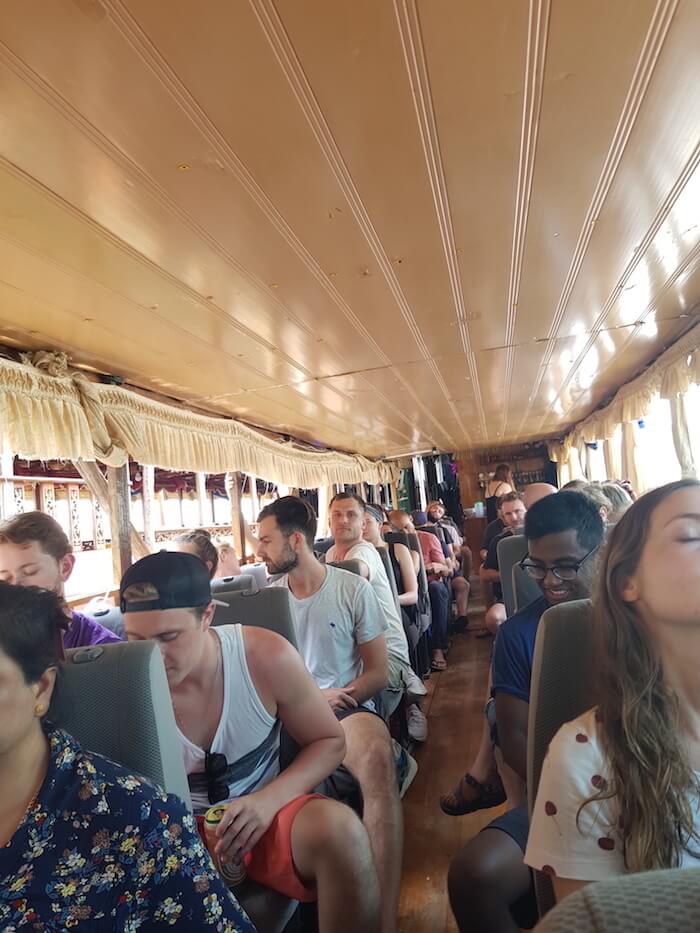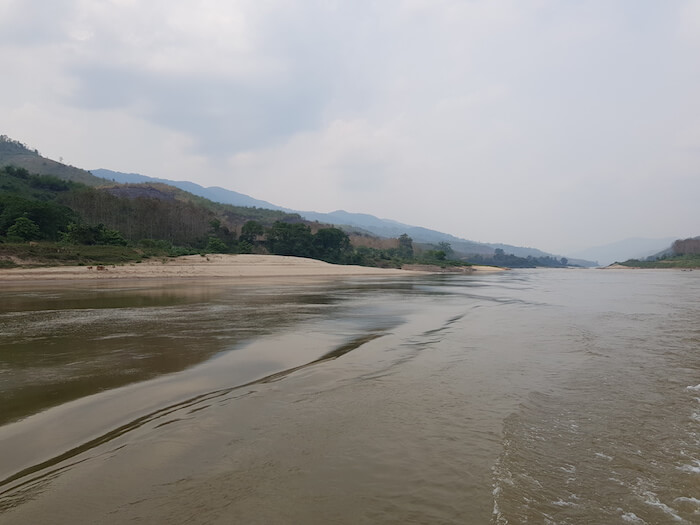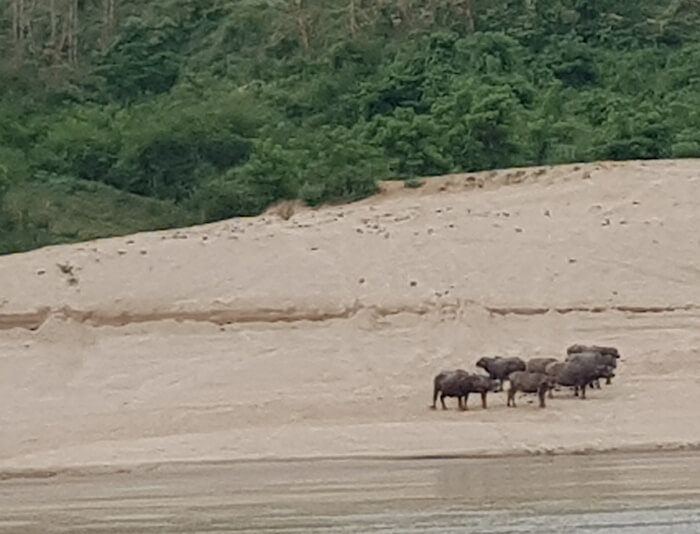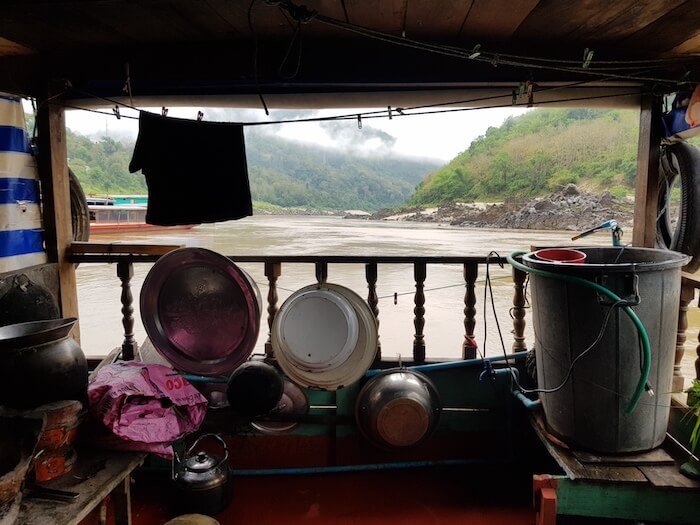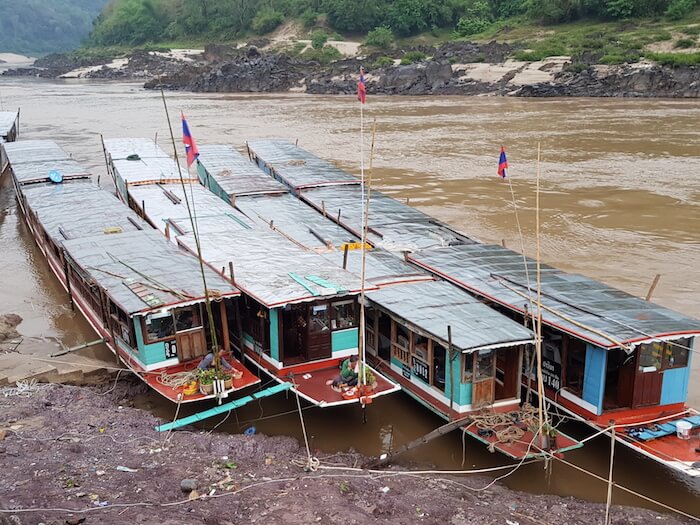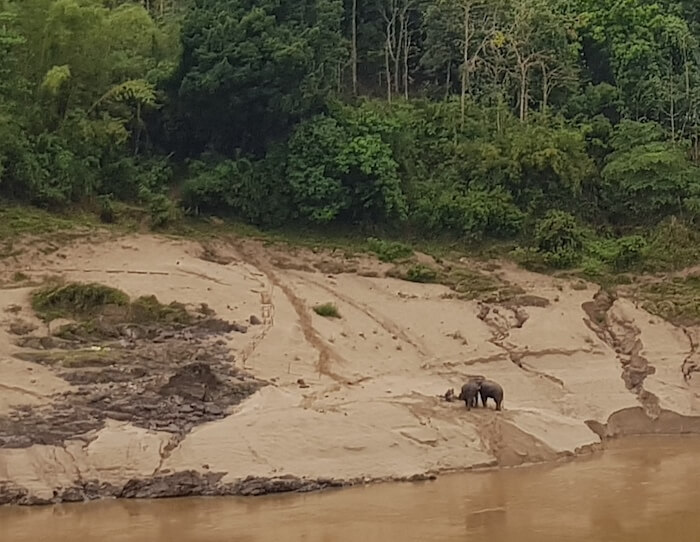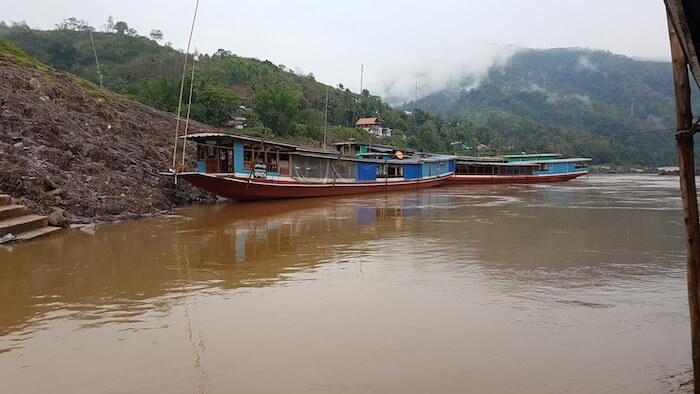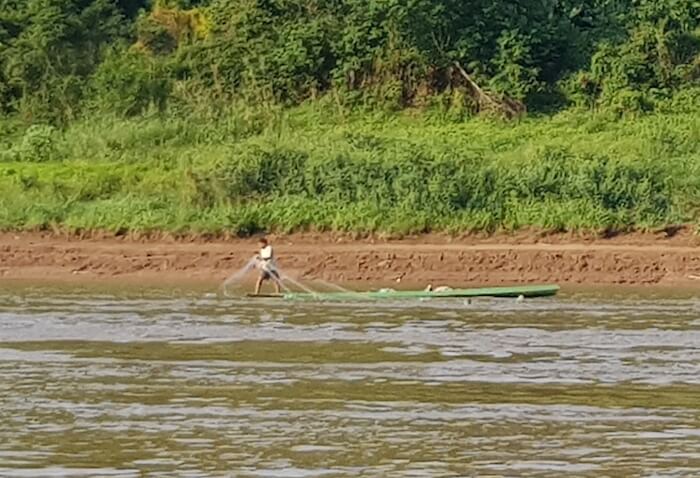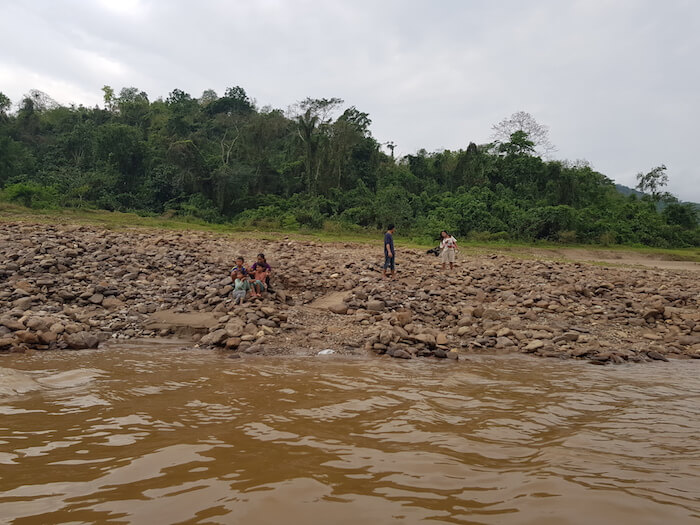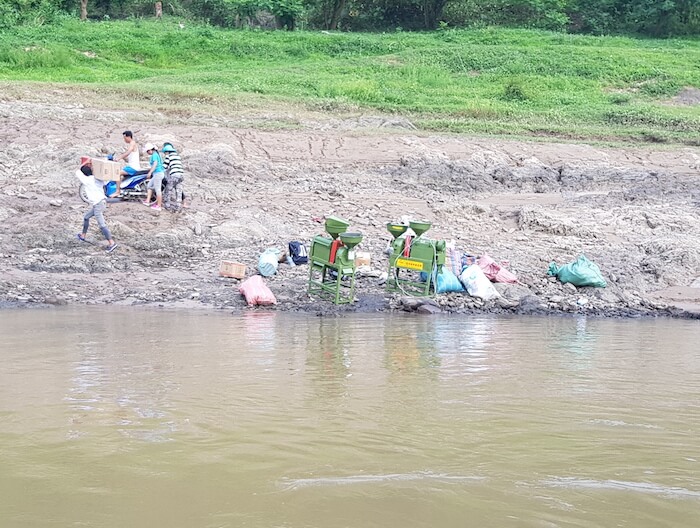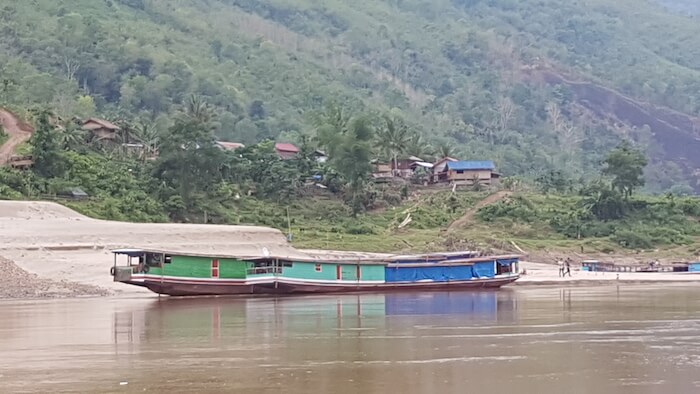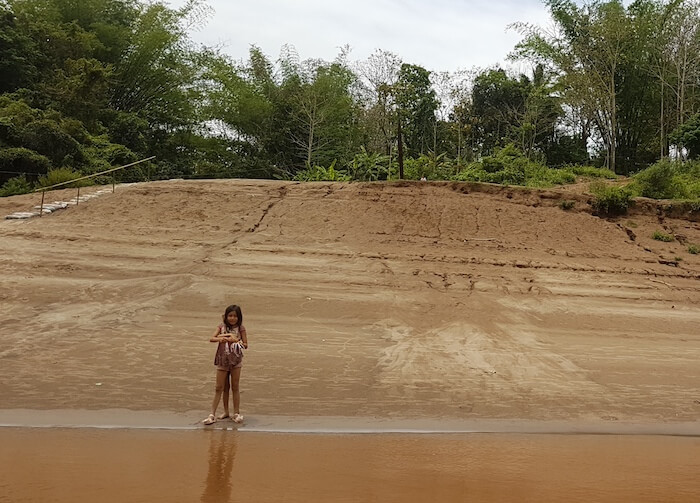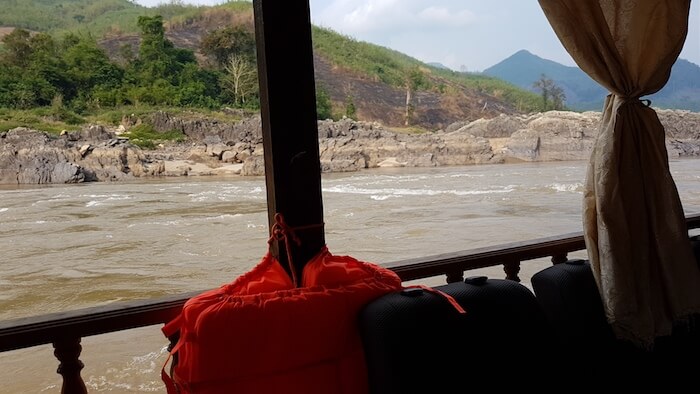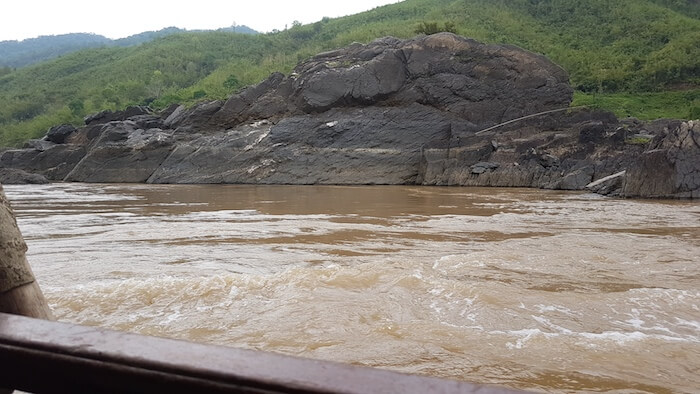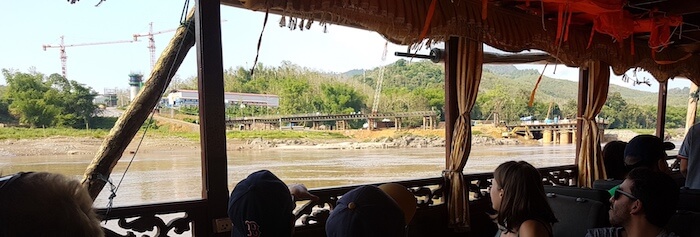Huay Xai to Pak Beng
For centuries the Mekong River has been the major highway of Laos and beyond, carrying people, animals, goods, concepts and cultures to places distant.
The Mekong River rises in the Himalayas in China, in the ‘three-rivers’ area. As it flows south it forms the border between Laos, Myanmar and Thailand. The river continues its journey through Cambodia and discharges into the Mekong Delta in southern Vietnam.
There are many ‘Slow Boats’ but the one most often referred to plies from Huay Xai in Laos (directly opposite Chiang Khong in Thailand) to Luang Prabang, Laos. The numerous boats and staggered departure times cater for the vagaries of Laotian border immigration. The Slow Boat route covers 297 kilometres of the Mekong River, through rain forest covered, mountainous country, peppered occasionally with small, remote villages.
- ROUTE OF THE MEKONG RIVER SLOW BOAT.
- The Slow Boat departure point.
- The boarding point at Huay Xai.
The minivan dumped us at the edge of the river – a very unprepossessing start point for such a iconic journey.
For the first few kilometres of the Slow Boat journey Laos is on the left and Thailand on the right. The river fairly quickly leaves Thailand.
- Ticket to Luang Prabang.
- DAY ONE OF THE SLOW BOAT JOURNEY.
- Luggage storage near the stern of the Slow Boat.
The Mekong River has many names. In China, it is known as the Lancang Jiang, meaning ‘turbulent river’. The Thai and the Lao refer to it as Mae Kong or Mae Nam Kong, meaning ‘mother water’. In Cambodia it is known as Tonle Than – ‘great waters’. In the delta, where the river splits into multiple branches, the Vietnamese refer to it as Cuu Long, meaning ‘nine dragons’.
75% of the Mekong’s annual flow falls with the monsoon between July and October. This huge surge of water is referred to as the ‘flood pulse’, and causes extensive flooding, particularly in the lower reaches.
- Mostly Farangs on board.
- Where we have been – the view from the stern. 1700 kilometres of the Mekong is in Laos.
This concentration of rain July to October causes the Mekong River to have the greatest ‘hydrological variability’ (high and low flow) of any river in the world.
Despite the extreme seasonal variations in flow and the presence of rapids and waterfalls making navigation difficult, the Mekong is a major trade route between western China and South-East Asia.
- Construction site on the northern bank.
- Cattle on the river bank.
There are many ‘Slow Boats’ plying the river. Of traditional design, the rudder is at the stern; the controls are 50 metres forward at the bow. Clearly, controlling such a long, shallow draft boat requires the skipper to make some anticipatory adjustments to his line. A deft skill that requires much practice if the boat is not to end up on the rocks.
The Driver obviously knows his way very well because there are no guideposts. If there any markers, they are well disguised. River pilot esoterica.
- Riverside village beach.
- Passengers have to go to wherever the Slow Boat can get in.
- This guy’s pickup point.
The Mekong River is claimed to be among the most biologically productive of all systems on earth. It is still a very wild river, not very populated. No heavy industry, no large cities and, until recently, no dams along its entire length. Although development is occurring, there are still very few bridges over the river.
- Riverside village.
- Looking back upriver. The Mekong is somewhere between 4350 km and 4909 km in length depending on who is telling the story. It is either the 8th or 12th longest river in the world.
- Passing a fishing boat. The Mekong River produces about 2.6 million tonnes of fish per year. This is about 13 times the marine fisheries sector of Australia.
- High voltage power lines across the river.
Water buffalo watched our passage.
- Water buffalo.
- Riverside village.
- Passenger pickup.
- Remote village
As the Slow Boat made its way along the Mekong we passed through many rapids – really just fast glowing water.
Grey metamorphic rocks, some tilted at extreme angles by forces beyond the comprehension of this very amateur geologist, form the banks for many kilometres. And for much of the journey they are not that far away. The channel is indeed narrow for such a large boat.
- A marker on the rocks.
- The Pak Beng bridge allows Route AH13 to cross the Mekong River, 12 kilometres upriver from the overnight stop.
- Arriving at Pak Beng.
- BKC Villa in Pak Beng.
The journey to Luang Prabang breaks at Pak Bang, 137 kilometres downriver from Huay Xai. Our hotel was prebooked and the ride in the truck style tuk tuk up the steep incline away from the ‘pier’ took only a couple of minutes. Pak Beng’s main reason for existence is as service village for passengers on the Slow Boat. A few hotels, eating houses, touts and very little else.
We stayed at BKC Villa. Mine host had learnt his trade in Singapore. A wild tropical storm hit just after dark, disrupting power and blackening the village. The storm passed through, the lights came back on, and it was time to eat, drink and party.
Pak Beng to Luang Prabang
- Greet the morning at the BKC Villa, Pak Beng.
- Long boats at Pak Beng. The women is entreating the boat nymphs to protect the boatmen and keep them safe.
Although of the same classic shape and length, today’s Slow Boat was different enough to offer a totally new experience. The engine hold was totally open and a revelation to anyone with even a mild interest in antiques. The low roof and 90-100 passengers made it mildly claustrophobic. I counted 12 lifejackets.
- A view from the rear of a houseboat moored at Pak Beng.
Luang Prabang is 160 kilometres downriver, through very remote country. No roads touch the river in this entire section of river. The Mekong is the only means of transport to the outside world.
- ROUTE OF DAY TWO OF THE SLOW BOAT JOURNEY
- The green boat is coming in to moor at Pak Beng.
- Houseboats berthed at Pak Beng.
- Early morning at Pak Beng.
- Misty morning at Pak Beng.
The river ferry work is shared around with everyone in the Pak Beng community.
- Elephants on the southern bank at Pak Beng.
- Looking upriver in the early morning at Pak Beng.
One of the passengers who was staying at our hotel had food poisoning – one of the hazards of travelling in South East Asia. He and his partner would catch tomorrow’s Slow Boat.
- Boarding the Slow Boat for the trip to Luang Prabang.
With the Laotian New Year celebrations in full swing the departure time was uncertain, however, we got away at 9.20 a.m.
- Long boats berthed at Pak Beng as we depart.
- Leaving Pak Beng.
The Slow Boat is about 50 metres long and draws about one metre. The seats are reclaimed from cars. None of them are bolted to the floor, including the Driver’s. The Co Driver sits next to him on a plastic garden chair.
The term ‘Slow Boat’ is really a misnomer. Long Boat would be more accurate. On the wide open stretches of water heading downstream these big wooden boats get along at a very respectable 25-30 kilometres per hour.
- Mekong River on the second day of our journey.
- Fisherman. With somewhere between 770 and 1200 species, the Mekong has a very high fish biodiversity.
Throughout the day there were a number of pickups and drop offs on both sides of the river. No jetty or designated landing place – just wherever the boat could get in. At one pickup the Driver had to move from his first selection to a spot 200 metres upriver. The new passengers had to hurriedly scramble over rocks to get to the amended location. There seemed to be an understanding that the Slow Boat would not wait for long.
- Passengers waiting for pickup.
In the middle of the afternoon and about halfway to our overnight destination we disembarked a Loatian family on the starboard bank – replete with two rice milling machines, a motorbike and sundry other items.
- Makeshift landing.
- Locals offloading rice machine.
- Offloading rice machine.
- Rice machine and other goods successfully landed.
Push back into the current and the journey continues.
- The view from the stern.
- Long boats at a small village.
From its source in China to the border with Laos, the river drops very rapidly – 4500 metres. This tremendous drop, through narrow valleys, makes this section of the river particularly suitable for generating hydropower. And although the course of the river in Laos is through very mountainous country, the drop is a lot more gentle.
- The second boat had a bit more room than the first.
Another motorbike was hauled on board. And a brand new one was taken off. The entire village turned out to see the new acquisition. The new owner then had the challenge of getting it from where it was deposited on the rocks up to the village. The Slow Boat continued downriver.
- Rock banks.
Some of the local passengers had backpacks, most had sacks. One passenger brought aboard a TV in a makeshift sling arrangement. Whatever works.
The river had been up to three metres higher fairly recently. The hundreds of sandbars told the story.
- Evidence of a previous higher water level at this pickup point.
- Passenger pickup at an isolated village.
Early afternoon and we stopped again at another village. Our sixth stop today.
It was just after one in the afternoon when we stopped for the seventh time to board passengers. The boat was now full. Overfull, actually. The passenger to lifejacket ratio had dropped to about 9:1.
- Moving along the river.
- Passing through a small rapid.
- Rocks line the bank.
It was still quite cool on the river. The sun hadn’t been able to penetrate the thick cloud cover to put some heat into the river valley.
Unlike yesterday, locals outnumbered the foreigners taking the Slow Boat to Luang Prabang.
- Looking downriver.
The occasional ferry (Slow Boat?) passed us going upriver – virtually empty. It seems the boats had to get back upriver but people didn’t.
- Another pickup at an isolated village.
Our eighth stop was to pick up two young guys standing on some rocks. It would seem that the way to catch the Slow Boat is to signal the Driver from the bank and then go to whatever spot on rocks to which he can manoeuvre the boat. Or a sandbank if more fortunate.
Our next stop proved tricky for the Driver to manoeuvre the Slow Boat to the pickup point. With nearly a flat bottom and a very shallow draft the ferry is no easy task to manoeuvre in the strong current. Other passengers arrived in a small, long-tail boat just in time to get aboard the Slow Boat.
- A set fishing pole.
Some of the rocks in the middle of the river had concrete blocks built on them. These are clearly favourite fishing spots that the local fishermen want to be able to access when the river rises.
Closer to Luang Prabang the villages are more frequent and the river is wider and calmer.
The Driver showed his skill once again as he deftly placed the prow of the Slow Boat on the shore within millimetres of a moored, small, long-tail boat. The slightest mistake by the Driver and the moored boat would have been crushed.
- Boatshed at a village.
The Pak Ou Caves are about an hour upriver from Luang Prabang. Some Slow Boats stop here for sightseeing, some don’t. Ours didn’t.
The river valley widens approaching Luang Prabang; the villages are larger and telecom towers are more frequent.
- Bridge under construction.
- Bridge under construction at Luang Prabang.
Arrival at Luang Prabang (sort of) is a cleverly disguised, virtually undetectable scam. I noticed that the ‘locals’ do not disembark. Tourists are disembarked here and struggle up the hill with their luggage to do battle with the Tuk Tuk Mafia for the trip into town. Whether the Slow Boat skippers get a kickback from the mafia for so conveniently terminating the trip here is difficult to judge. What is clear, however, is that stopping a few kilometres short of the tourist mecca of Luang Prabang creates a lucrative transport opportunity for the Lao tuk tuk drivers.
We continued our tour of Laos in Luang Prabang.
© Kim Epton 2019-2024
2090 words, 63 photographs.
Feel free to use any part of this document but please do the right thing and give attribution to adventures.net.au. It will enhance the SEO of your website/blog and Adventures.
See Terms of Use.
